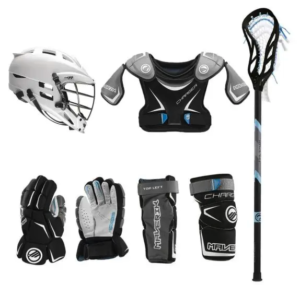It’s easy to feel a little overwhelmed by the amount of equipment that the game of lacrosse requires. If you’re just starting out, and your priority is to participate fully, comfortably, and–most importantly–safely, you’re probably looking for a general idea of what you need to get rolling. Don’t worry, we have you covered! For an overview of boys’ and men’s beginner lacrosse equipment needs and key things to consider as you get started, read on below.
Table of Contents
Casual Backyard Play vs. Joining a Team
This is the first decision you need to make. If you are new to lacrosse and just want to learn how to use a stick, catch and throw with friends, and play in the backyard, then all you really need is a lacrosse stick and one or two balls. You can read our buying guide on complete sticks for new and younger players here.
More protective lacrosse equipment is required if you’d like to join a local lacrosse team and participate in competitive play. In addition to a lacrosse stick, the equipment requirements for boys and men include:
- Helmet
- Shoulder Pads
- Arm Pads
- Gloves
- Mouth guard
Optional (but recommended) equipment includes:
- Protective cup
- Cleats
- Rib pads
Read on for a more comprehensive overview of these pieces of lacrosse equipment that are required to compete as part of a team. I’ve included some necessary considerations, some ‘good to knows’, and some links where you can take a deeper dive on my favorite pieces of lacrosse equipment.
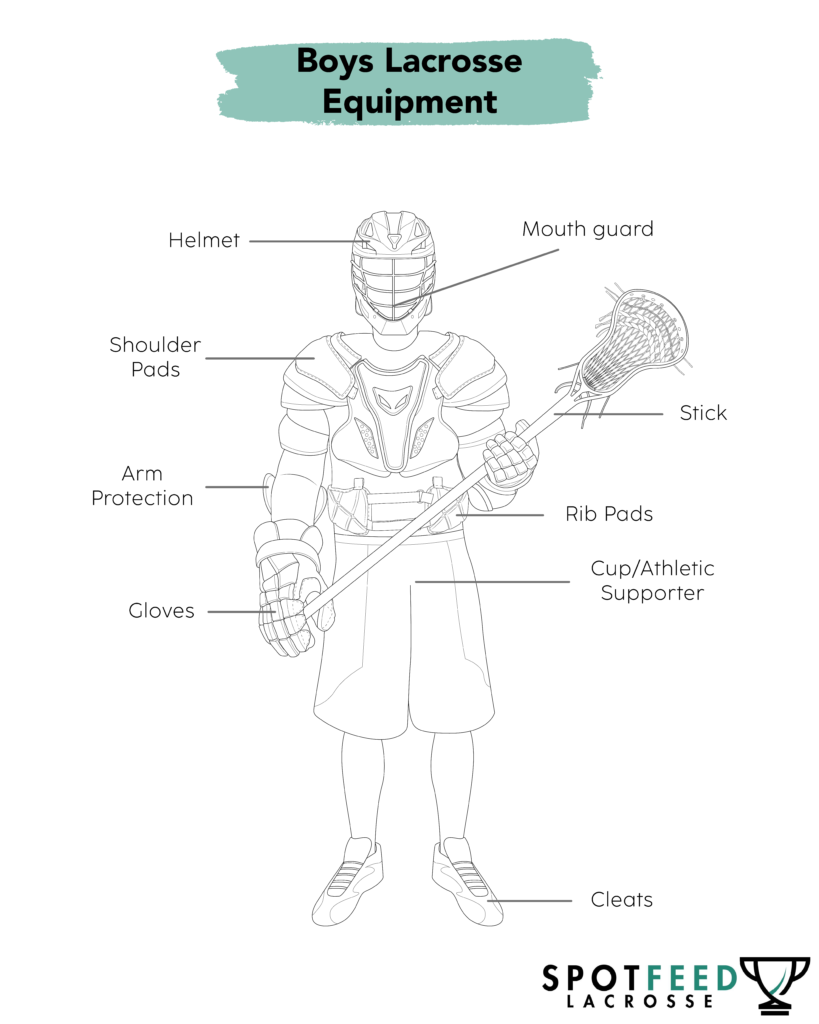
Safety Considerations
The first consideration for anyone playing lacrosse is to make sure you can enjoy the game safely.
While basic lacrosse equipment requirements won’t change from league to league, there have been advancements in protection and safety features that many leagues are now requiring for boys’ and men’s lacrosse players. Specifically, check whether your equipment meets NOCSAE safety standards (National Operating Committee on Standards for Athletic Equipment).
You can check for a “Meets NOCSAE Standard” label on any lacrosse equipment you’re planning to use, and make sure that, if you’re using gear that was borrowed or previously owned, it’s been re-certified as needed.
We make recommendations with NOCSAE protective safety in mind, but make sure you check your league’s rules before taking the field.
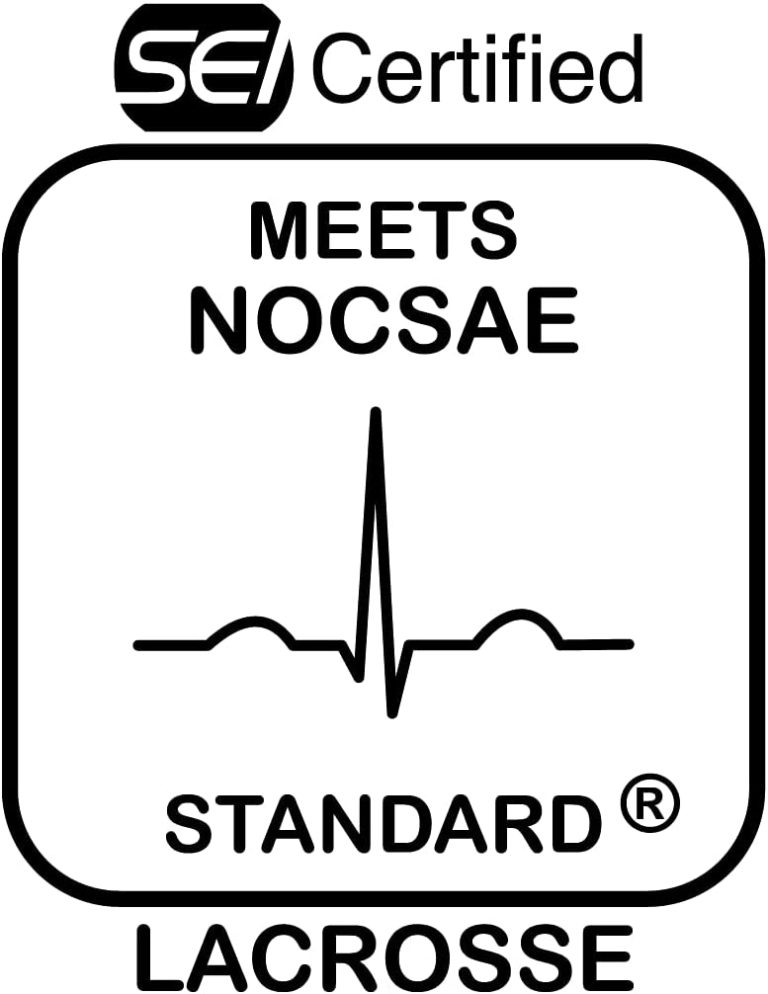
Essential Lacrosse Protective Equipment
Helmet
Lacrosse helmets have a hard plastic exterior to protect the head, with an adjustable interior and a chin strap. They have a face mask that’s similar to hockey masks but with a couple of key differences. Specifically, lacrosse face masks are more rigid and allow a different field of view than hockey masks do. Ground balls are a huge part of the game, so lacrosse helmets allow for more downward peripheral vision.
[A good fit around the head is key to a lacrosse helmet’s safety – check out our tips on fitting your helmet here. -crosslink]
Shoulder pads
Shoulder pads slide over the head, protect the top of the shoulders, chest, and upper-back, and can have detachable upper arm guards to protect the upper arm as well.
Arm Pads
Arm pads come in a variety of styles, including full-length arm pads to minimalist styles that cover only the elbow (utilized by some college and professional players, but not recommended for youth).
Many youth leagues recommend the better protection of full-sized arm guards for a young player who’s new to the game. As you settle into a position, you may choose lighter and more mobility-focused arm pads (common for defensemen, who typically take fewer checks to their arms), or higher-coverage pads (common for attackmen, who typically take a higher volume of stick checks to their arms).
Gloves
Lacrosse gloves protect the back of the hands and wrists with thick padding, and use lighter materials for the palm so that players can maintain grip and control while holding their lacrosse stick.
Mouth guard
All lacrosse players are required to wear a mouth guard, and mouth guards typically need to be a contrasting color so that referees can easily see that you have one. Most can be molded to your mouth at home for a comfortable fit, and come with a tether that can attach to the face mask of most helmets.
Optional Lacrosse Gear (Recommended)
Protective cup
These cover the male genitals and are a critical part of player safety in a fast-paced physical game like lacrosse. It’s easy for a lacrosse stick or ball to accidentally strike players in this region. For that reason, protective cups should be part of the mandatory lacrosse equipment list in all boys’ and men’s leagues.
Cleats
Traction and maneuverability are critical for the “fastest game on two feet.” Lacrosse cleats have plastic or rubber soles with protruding studs to help you keep a solid grip of the field while running. Studs can be molded or detachable for natural fields, or for synthetic surfaces, turf shoes have lots of small rubber nubs.
Cleats also come in low, mid, and high-cut versions to match different positions and play styles: low for more speed and agility; high for more stability. They may be optional for practice, or for certain age groups, so be sure to check your league’s rules and requirements.
Rib pads
Rib pads cover the side of the torso and the kidneys. They provide increased protection but many players opt not to wear them because they can decrease mobility and hinder the ability to maneuver properly.
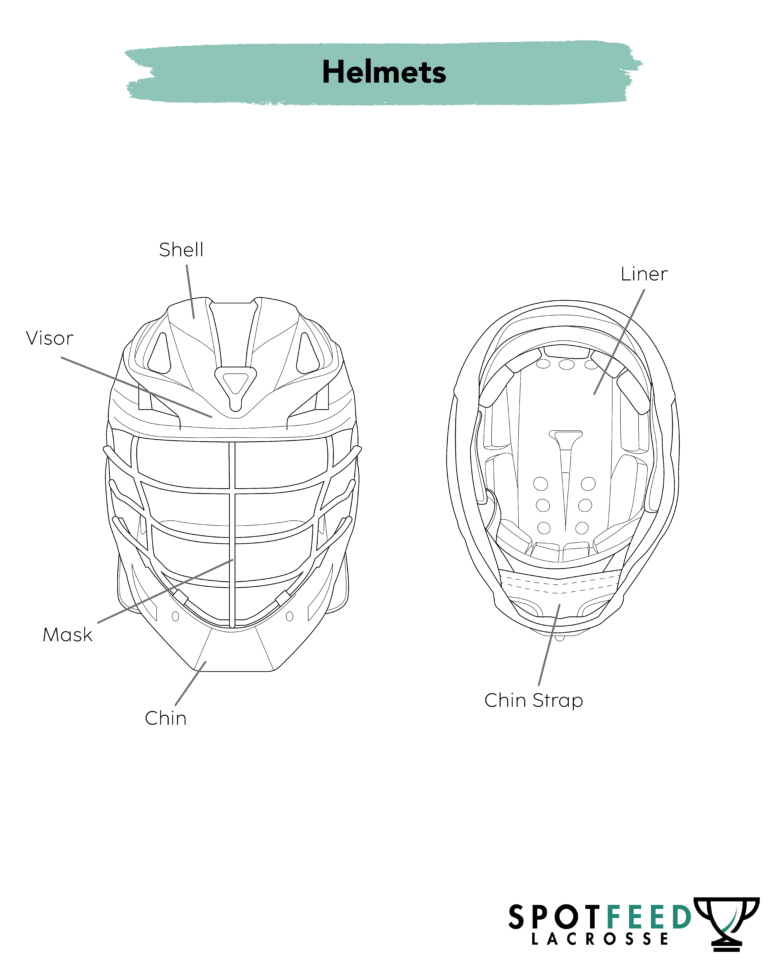
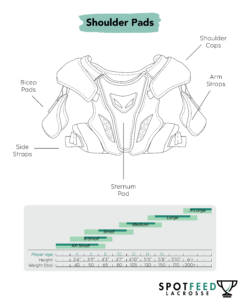
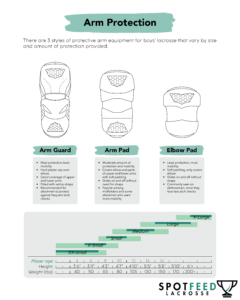
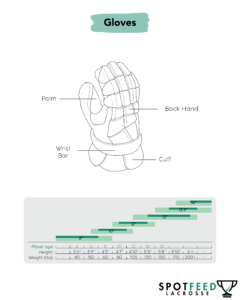
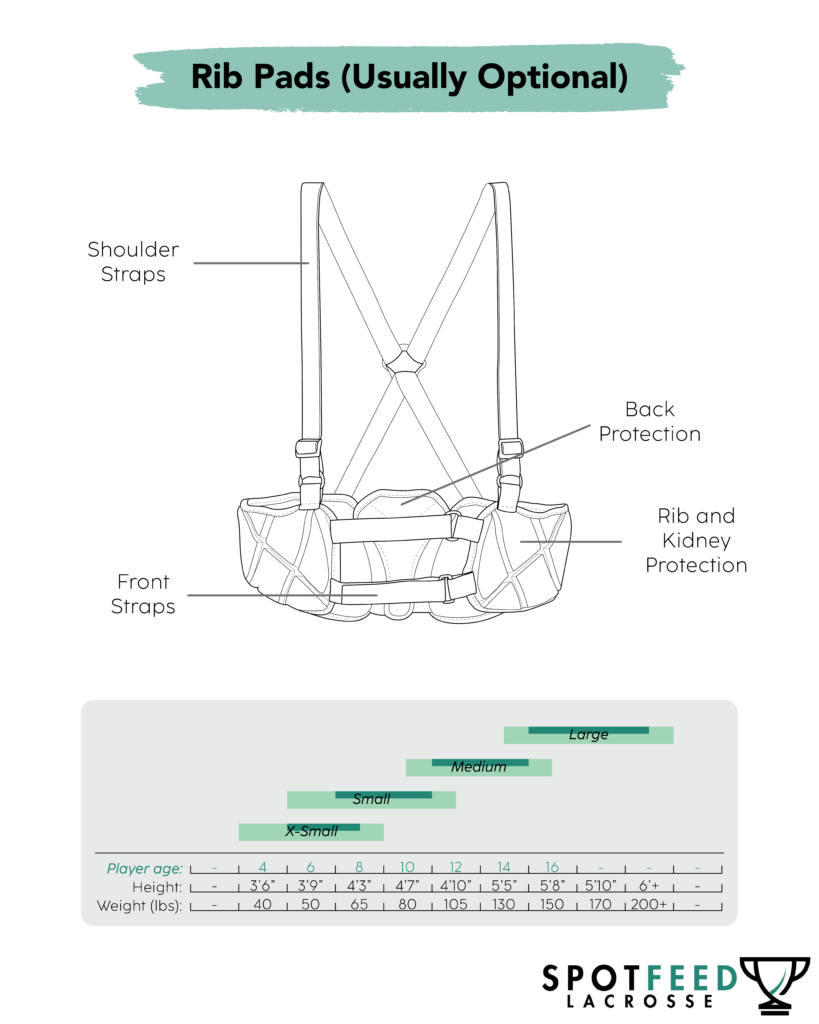
Youth Lacrosse Starter Sets
Some online retailers package together the core lacrosse equipment items in “lacrosse starter sets.” At minimum, these come with arm pads, shoulder pads, and gloves. Most provide the optional add-on of a helmet and/or stick and some even provide optional add-ons of accessories like mouth guards, balls, etc. Below are links to one easily available option, but check out our guide on starter sets for more options: 3 Best Youth Lacrosse Starter Sets
Additional Shopping Considerations
Goalie-specific lacrosse equipment
The goalie position has its own unique lacrosse equipment requirements. Goalies are NOT required to wear shoulder pads and arm pads like other players, but they ARE required to wear a full chest protector that covers the shoulders, chest, stomach and ribs.
Goalies are also required to wear a throat protector (which is a durable plastic guard that easily attaches to the bottom of any standard helmet), and goalie-specific lacrosse gloves that have more protection and padding on the thumb. Goalies may also decide to use shin or knee pads, although these are not required.
For more information on lacrosse equipment for goalies, check out our product guides:
Used Lacrosse Equipment
Boys’ lacrosse equipment needs may seem daunting at first, but there are a lot of avenues for new players to find and purchase solid, affordable gear. If you’re not ready for a big investment yet, check with your teammates and other players in your league – they may be able to loan you equipment as you get started with your first season.
Also, remember that every player out there has outgrown (or will outgrow) a set of gear at some point! This is especially true for youth lacrosse, when boys are still growing rapidly from year to year.
You can check your local sports-equipment stores or online marketplaces–both general and sports-specific, like SidelineSwap–-for used gear that won’t break the bank. For more resources on navigating the used gear buying process, check out our full guide on used lacrosse equipment.
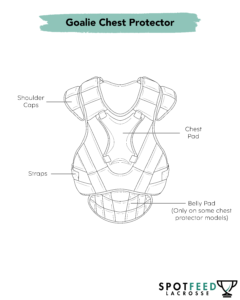
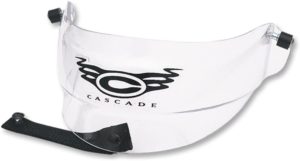
Cleaning Your Lacrosse Equipment
Sports gear can get funky. It’s the lurking threat to every player and parent’s experience. You’ve invested in lacrosse equipment that you trust to keep you safe and help you play your best, but how do you make sure that it’s fresh enough to put on day after day?
Stinky gear isn’t just unpleasant for you and those you’re around–lack of proper care can shorten the life of your equipment and put you at risk for infections. It’s just as true in lacrosse as in anything: take good care of your lacrosse equipment, and it’ll take good care of you.
Prevention and maintenance
Getting into an everyday maintenance routine from day one is the best and easiest way to keep your equipment in good shape. Done properly, it’ll lengthen the life of your lacrosse equipment, and prevent the buildup of the bacteria that cause that funky smell. Those bacteria can show up as acne, or infect your skin through cuts and scrapes, so clean and well-cared-for equipment can protect you in more ways than just on the field.
Keys for keeping your lacrosse gear clean
- Take gear out to dry: Always take your gear out of your lacrosse bag after playing and hang it up to fully dry. This will prevent bacteria from running rampant inside a soggy bag (and it’ll keep your bag from getting smelly too!).
- Wipe it down: Give your gear a once-over. Wipe away any sweat or dirt with a damp cloth.
- Use a sports cleaning spray: Sprays like Vapor Fresh or Clear Gear disinfect as they dry, so all you need to do is spritz it on and leave it be. Avoid using cleaning sprays with harsh chemicals like bleach, chlorine, or ammonia–these will damage your equipment.
- Think about storage: Cleaning your gear won’t get you very far if your bag is grungy. Give it the same treatment as your equipment: Wipe it down if needed, let it dry, and consider a spray. You can also pop in a gym bag deodorizer for another line of defense. Finally, consider a couple sets of glove dogs for gloves and cleats. These inserts contain cedar chips or a similar substance, and will help dry and deodorize some of the hardest-to-reach places in your gear.
- Don’t forget the mouth guard: Mouth guards can hang on to their own types of bacteria. Brush your mouth guard with toothpaste, just like you would your teeth. Rinse it with cool water and let it dry.
- Deep clean: If you notice that your lacrosse equipment is starting to get a little less-than-fresh, a deeper clean might be in order. Regardless, it’s a good idea to plan for a deep clean every few months, to keep your gear and yourself in top shape. Find a routine that works for you and stick with it.
How to Clean Each Piece of Your Lacrosse Equipment
Shoulder pads, arm pads, & chest protector
Some pads are machine-washable, but be sure to check the labels on your equipment before throwing them in the washer. If your gear can go in the machine, use the delicate cycle with cold water and a little bit of mild detergent.
If your gear needs to be hand-washed, fill a tub with cold water and a small amount of a mild detergent. Let your pads soak, and then gently scrub any stubborn spots clean with a cloth. Rinse well in the shower or with fresh water in the tub.
Never put your pads in the dryer! They can shrink, deform, and otherwise get damaged, making them less safe. Squeeze any excess water out of the pads and hang them up to dry.
Larger or heavier sets may take a day or two to dry completely, but make sure everything is fully dry before storing it again. You can stuff newspaper or a washcloth inside wet pads to help with the drying process.
lacrosse gear
Read our shoulder and arm pad guide here
Lacrosse gloves
Many gloves these days are made with leather, which means they’re not a great fit for the washing machine. You can wipe gloves clean with a damp cloth and rinse the palm with cold water. Stuff gloves with newspaper and leave them open-side-up to dry completely. Once they’re fully dry, consider storing them with a set of glove dogs inside to absorb moisture and smells.
lacrosse glove
Read our guide for choosing gloves here
Helmet
Helmets get sweaty real quick. Using a damp cloth with cold water and mild detergent (something that won’t irritate your skin), wipe down the inside of your helmet. Be sure to scrub the face mask and chin strap, as bacteria here can get into pores and cause acne, or into cuts and cause other infections. Let it dry completely, and give it a good spray with a sports cleaning solution to disinfect.
lacrosse helmet
Read our tips in selecting the best helmet here
Cleats
Using cool water and a damp cloth, wipe your cleats down. Rinse and scrub them as needed to remove any dirt. Remove the insoles and any pads inside the cleats, open them up as much as possible, and allow the insoles and cleats to dry completely.
As with gloves, you can stuff newspaper in the cleats to help with the drying process. Use a sports cleaning solution to disinfect. Once the insoles and cleats are fully dry, reassemble them, and consider storing them with their own set of glove dogs to keep moisture away.
lacrosse shoe
Read our guide on how to choose the perfect cleats
Your lacrosse equipment is an investment in your safety and comfort as a player. Get the most out of it by maintaining it well, and you’ll be setting yourself up for success on the field.
FAQs
The equipment that is required for organized lacrosse is a helmet, shoulder pads, arm pads, gloves, and a mouth guard. Other equipment that is recommended but not always required includes cleats or turf shoes, a protective cup, and rib pads.
Lacrosse sticks are usually called just that: sticks. Sometimes a lacrosse stick is alternatively referred to as a “crosse” or “pole,” but “stick” is the most common term.
For beginners, it is recommended to start out with a complete lacrosse stick, which comes ready-to-play with stick, head, and mesh all attached together. More advanced players may purchase these items separately to customize their sticks to their personal preferences. Oftentimes, a more advanced player will choose a lacrosse stick based on the position they play.
Lacrosse equipment can be bought at many brick-and-mortar and online retailers. These include stores like Dick’s Sporting Goods or local lacrosse specialty stores for shopping in person, and online retailers like Lacrosse Monkey, Lacrosse Unlimited, and even Amazon.
Cheap lacrosse equipment can be found at most lacrosse retailers, as they usually sell items at different price ranges and for different skill levels of players. However, you can also find cheap used lacrosse equipment at physical stores like Play it Again Sports or online marketplaces like Sideline Swap.

